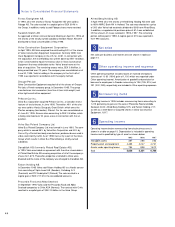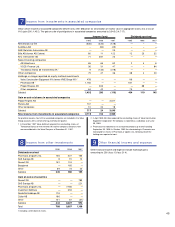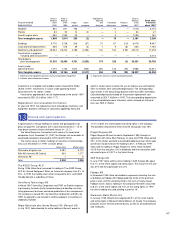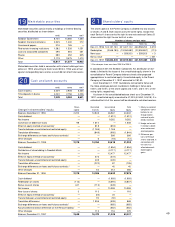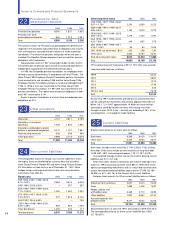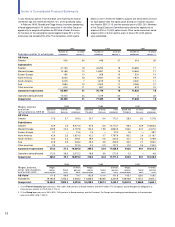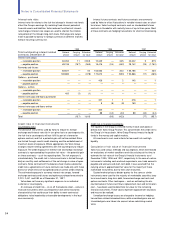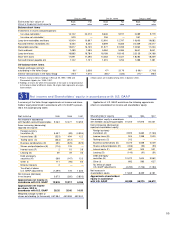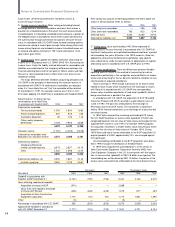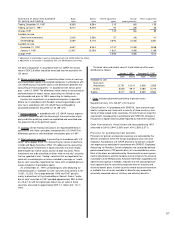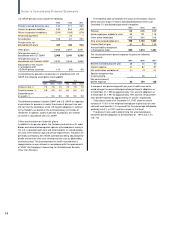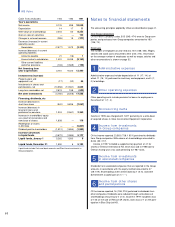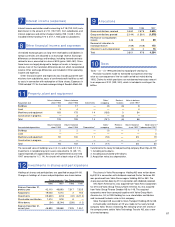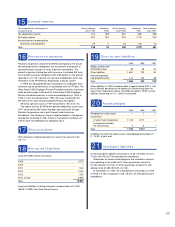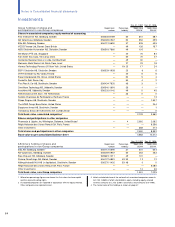Volvo 1997 Annual Report Download - page 56
Download and view the complete annual report
Please find page 56 of the 1997 Volvo annual report below. You can navigate through the pages in the report by either clicking on the pages listed below, or by using the keyword search tool below to find specific information within the annual report.
54
Interest-rate risks
Interest-rate risk relates to the risk that change in interest-rate levels
affect the Group’s earnings. By matching fixed-interest periods of
financial assets and liabilities, Volvo reduces the effects of interest-
rate changes. Interest-rate swaps are used to shorten the interest-
rate periods of the Group’s long-term loans. Exchange-rate swaps
make it possible to borrow in foreign currencies in different markets
without incurring currency risk.
Interest futures contracts and futures contracts are commonly
used by Volvo to offset fluctuations in variable interest rates on short-
term loans. Volvo has liquid contracts, such as standardized futures
contracts in Eurodollar with maturity terms of up to three years. Most
of these contracts are hedging transactions for short-term borrowing.
1995 1996 1997
Total outstanding interest related Notional Carrying Estimated Notional Carrying Estimated Notional Carrying Estimated
contracts, December 31 amount amount fair value amount amount fair value amount amount fair value
Interest-rate swaps
– receivable position 84,354 11 2,905 10,349 — 335 20,322 9 875
– payable position 69,746 (167) (963) 15,416 (34) (462) 28,142 (25) (1,760)
Forwards and futures
– receivable position 83,621 — 52 153,553 — 303 165,186 — 435
– payable position 169,882 — (378) 170,670 — (550) 190,866 (17) (465)
Options – purchased
– receivable position — — — 426 — 2 145 — 1
– payable position — — — — — — — — —
Options – written
– receivable position — — — — — — — — —
– payable position 400 (1) (1) — — — — — —
Interest-rate caps and floors purchased
– receivable position — — — 301 1 1 376 — 1
– payable position — — — 8 (8) (8) 159 — —
Interest-rate caps and floors written
– receivable position — — — 300 — — — — —
– payable position — — — 88 (44) (44) 88 (44) (44)
Total (157) 1,615 (85) (423) (77) (957)
Credit risks in financial instruments
Counterparty risks
The derivative instruments used by Volvo to reduce its foreign-
exchange and interest-rate risk in turn give rise to a counterparty risk,
the risk that a counterparty will not fulfill its part of a forward or
options contract, and that a potential gain will not be realized. Risks
are limited through careful credit checking and the establishment of
maximum levels of exposure. Where appropriate, the Volvo Group
arranges master netting agreements with the counterparty to reduce
exposure. The credit exposure in interest-rate and foreign exchange
contracts is represented by the positive fair value – the potential gain
on these contracts – as of the reporting date. The risk exposure is
calculated daily. The credit risk in futures contracts is limited through
daily or monthly cash settlements of the net change in value of open
contracts. Since contracts off the balance sheet involve substantial
credit risks, agreements on future contracts are made only with those
banks for which limits are assigned based on careful credit checking.
The estimated exposure in currency interest-rate swaps, forward
exchange contracts and futures and options purchased amounted to
2,291, 2,441 and 380 as of December 31, 1997.
Volvo does not have any significant exposure to an individual
customer or counterparty.
An increase of credit risk – on or off the balance sheet – occurs in
financial instruments when counterparties have similar economic
characteristics that could cause their ability to meet contractual
obligations to be impaired by unfavorable developments in the busi-
ness community.
Credit risk in financial investments
The liquidity in the Group is invested mainly in local cash pools or
directly with Volvo Group Finance. This concentrates the credit risk to
the Group’s in-house bank. Volvo Group Finance invests the liquid
funds in the money and capital markets.
All investments must meet criteria for low credit risk and high
liquidity.
Calculation of fair value of financial instruments
Volvo has used various methods and assumptions, which were based
on evaluations of market conditions and risks existing at the time, to
estimate the fair value of the Group’s financial instruments as of
December 1995, 1996 and 1997, respectively. In the case of certain
instruments, including cash and cash equivalents, non-trade accounts
payable and accruals and short-term debt, it was assumed that the
carrying amount approximated fair value for the majority of these
marketable instruments, due to their short maturities.
Quoted market prices or dealer quotes for the same or similar
instruments were used for the majority of marketable securities, long-
term investments, long-term debt, forward exchange contracts and
options contracts. Other techniques – such as estimating the dis-
counted value of future cash flows, replacement cost and termination
cost – have been used to determine fair value for the remaining
financial instruments. These values represent approximate valuations
and may not be realized.
Unrealized exchange losses are charged to income for hedging
transactions related to booked items, while unrealized gains are not.
Unrealized gains are taken into account when calculating market
value.
Notes to Consolidated Financial Statements


